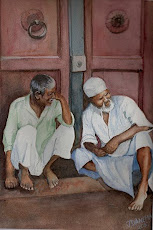
I finished a portrait recently and part of the work includes incorporating natural pigments into the mix.
Most of the paints for this work are Daniel Smith (from a paint firm that specializes in some unique inorganic, mineral-derived paints.) But the flesh tones incorporate French ochre, Nicosia Green Earth and Vermilion from Rublev (Natural Pigments)
The vermilion does NOT behave like pyrol red, naphthol red, cadmium red or any orange-red of organic origin. The tinting strength is very high but staining is low, meaning you can tint the rosy blush of flesh to a very precise level. Dropping vermilion (Rublev) into a semi-opaque wash makes an uncanny, glowing blush. No other paint behaves like it. The darkening of vermilion in some atmospheres is said to be mitigated by eliminating a chloride ion. I don't know if this is true, but the beauty of genuine vermilion is unsurpassed. You can also see it here, washing over the pyrol red in the head cloth and the apron.
Natural Pigments is supposed to be adding genuine gamboge, a rubber-like resin that is somewhat toxic and derived from the Garcinia tree of Southeast Asia (Gamboge and Cambodia derive from the same word.) I have a very ancient (1860's) lump of this resin and if you just drop a single, tiny drop of water on it, a brilliant yellow develops. The yellow of true gamboge is one of my favorite shades and I was unhappy in the 80's, when it went out of production. The color is not particularly lightfast compared to Hansa yellow or other yellows used to make New Gamboge. In light tints, you can usually find a substitute, but nothing is really as good as this beautiful sunny yellow. I can't wait to try it.


No comments:
Post a Comment